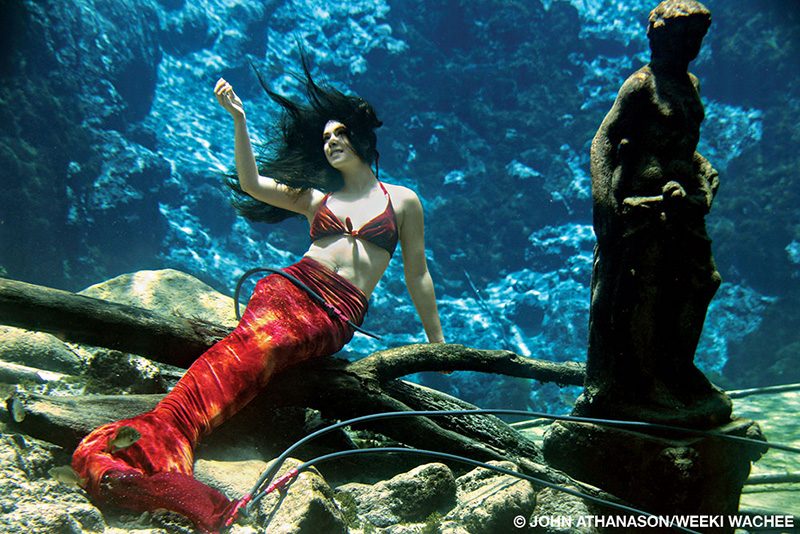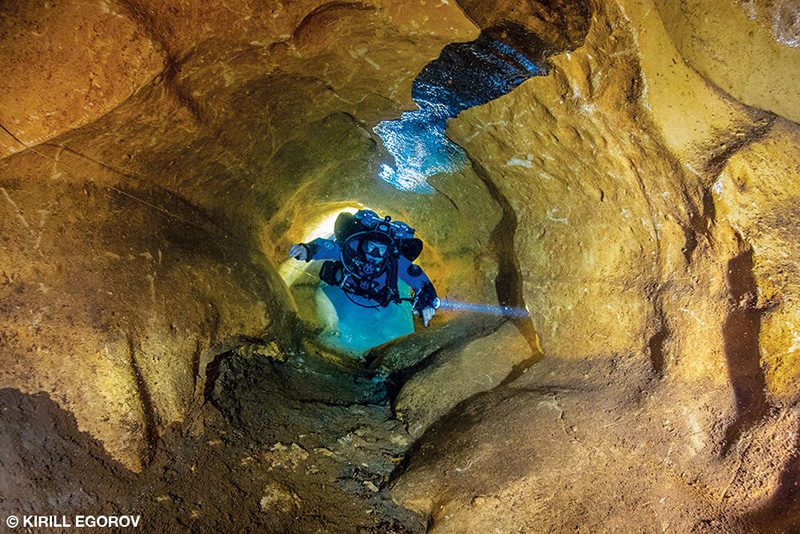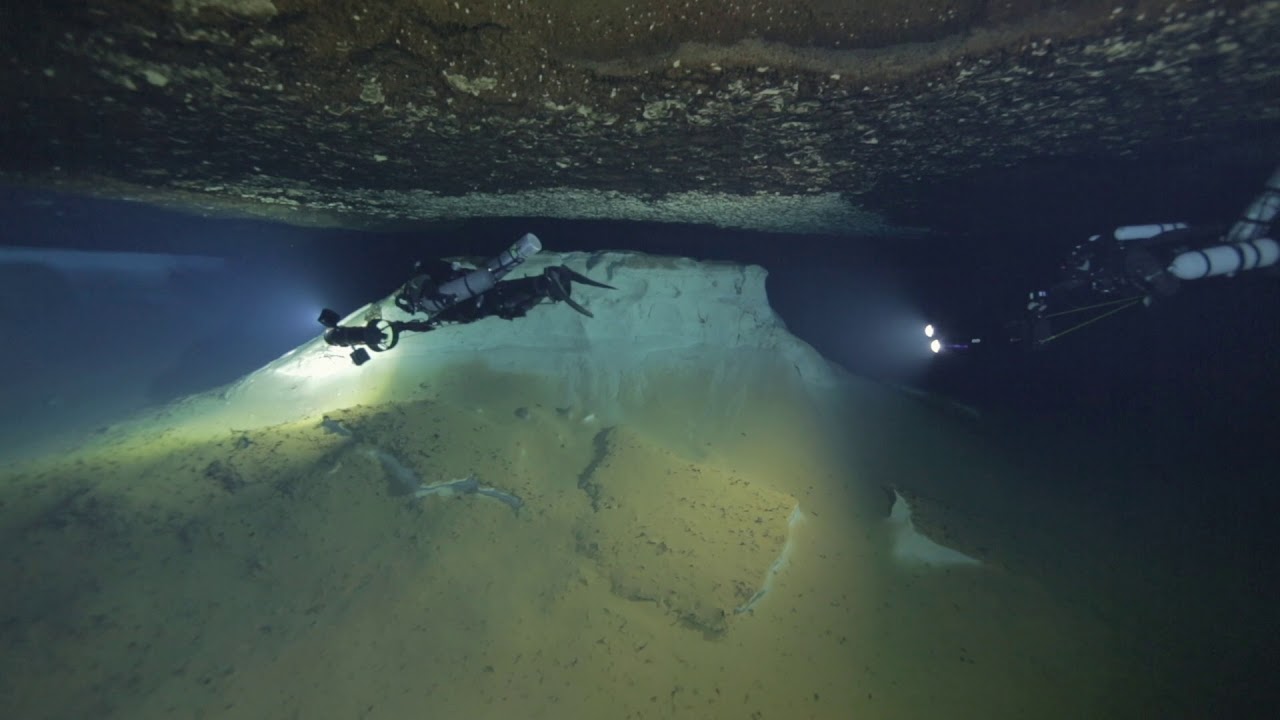This summer Brett Hemphill, Andy Pitkin, Matt Vinzant and their Karst Underwater Research (KUR) team plan to push a lead they discovered 8,000 feet back in a cave at a depth of 375 feet of fresh water (ffw) during a 12-hour dive — their last of the 2018–19 season. They hope it will help them to finally answer the question, “Where does the water come from?”
Finding that lead — a cobalt-blue window opening into a massive white passage that is likely a source tunnel, judging from its flow — represents the culmination of more than 12 years of dogged exploration of what has become the second-deepest and arguably one of the most extreme water-filled caves in the U.S.
Welcome to Weeki Wachee Springs in central Florida, about a hour’s drive north of Tampa. This first-magnitude spring, which discharges millions of gallons into the Weeki Wachee River, is home to 18 mermaids who perform daily in the 100-foot-wide underwater auditorium. Weeki has hosted mermaid shows since 1947, but until 2007 it was unknown whether the mermaids were guarding significant cave passages beneath their watery lair.

The cave, which until recently was accessible only when its outflow wanes during drought conditions, was essentially abandoned in the 1980s after famed explorer Sheck Exley barely managed to breech its violent entrance: a constricted firehose of a fissure named the “Gauntlet” that runs from from 40 ffw to 170 ffw before opening into the cave. Exley reportedly cleared the entrance with just 900 psi in his double LP104 tanks and laid 600 feet of line before tying off to what appeared to be an impenetrable breakdown pile.
“We’re not elitist,” explained Hemphill, 52, a professional diver who was the first to successfully negotiate the Gauntlet in a rebreather in 2007. “We were just in the right place at the right time with the right prep. The frontier made itself available.”
It has only been in the past decade or so that the requisite technology has been available to explore caves such as Weeki, creating what 52-year-old anesthesiologist Pitkin calls the “second golden age” of cave exploration. Even so, KUR’s dives are pushing the limits of technology and human endurance.
A Tale of Two Springs
Weeki’s near-impenetrable entrance proved to be a formidable barrier for nearly two decades. In 2000, after a long drought, underground veteran Paul Heinerth attempted to enter the cave with his rebreather but was rebuffed by the flow, which collapsed his counterlungs, rendering him unable to breathe. Within days the flow intensified, making the cave undiveable.
In May 2007, during one of the worst droughts on record, Hemphill managed to “claw his way” into the cave with a rebreather, swim to the end of Exley’s line and find an opening through the breakdown into a large tunnel heading west. That summer Hemphill, along with Heinerth and Corey Mearns, further explored Weeki and pushed its depth to 407 ffw, nearly 6,000 feet from daylight, making it the deepest underwater cave in the U.S. at the time.
The team realized they were dealing with a major deep system, but the logistics of transporting equipment into the cave remained daunting. No diving occurred in 2008, but a brief window in 2009 enabled Hemphill and Pitkin to extend the main tunnel to a terminal room without continuance as the drought ended.
Unable to access Weeki, in 2011 KUR turned its attention to Twin Dees Spring, a small, sleepy fount a half mile from Weeki with a stagnant 40-foot-wide basin that discharges into a small run. Heinerth and Eric Sanders discovered and explored the cave in the 1970s. At the bottom of the basin is a limestone chimney, barely wide enough to permit a diver in doubles to reach a small chamber called the “Fitting Room” at 40 ffw. From there a low bedding plane leads to several deeper chambers that Exley walled out, or so he thought.
In the 1990s the state of Florida commissioned Jeff Peterson and David Minor to map the property’s caves and directed their effort to Twin Dees. They discovered a lead to a stadium-sized room they named “Middle Earth” and an immense tunnel measuring 50 feet high and 120 feet wide at a depth of more than 300 ffw. They explored it to 3,700 feet before reaching the limits of their open-circuit support.

Despite its problematic entrance, Twin Dees proved to be the linchpin to unlock Weeki’s secrets. After a productive 2011 season extending Peterson and Minor’s line to within a breath-hold of Weeki, the team returned in 2014 to connect the two systems. Most important, they installed a decompression habitat in the Fitting Room to make their 10-plus hours of decompression manageable.
Within a month Hemphill and Pitkin made their first connection: a 7,000 foot traverse, including about a mile at an average depth of 300 ffw, allowing them full access to Weeki. Today the combined system stands at 30,868 feet, including the 5,892 feet that KUR added last year.
Extending the Technology
To safely pull two-hour bottom times at 300 feet plus average depths, followed by 10 to 14 hours of decompression beginning as deep as 200 to 250 ffw, KUR has extended available technology to its practical limits. Each diver wears a modified rebreather with twice the usual scrubber capacity and carries a custom-made, sidemount semiclosed rebreather. Both systems are fed by dual 120-cubic-foot sidemount deep bailouts and six to eight aluminum 80 stages for decompression.
They each carry two or three high-end scooters that they rotate on thirds and video lights to illuminate Weeki’s massive passages, and they wear electrically heated drysuits. The habitat itself, where divers typically spend four of their 10 hours decompressing, is a fully functioning rebreather with scrubber (divers can remove their mouthpieces) and boasts a Wi-Fi hotspot for the team’s livestream “habichats.”
What do they worry about most?
“There are 101 things that can can go wrong and compromise safety,” explained Pitkin, who relies on at least five checklists. “I worry about remembering everything we need to bring and do, like not forgetting to charge batteries, or having an equipment problem, a drysuit leak, cell failure or valve issue while we’re at the sharp end of the dive.” Not to mention making sure their catheters stay on. “Losing a cath is arduous,” Hemphill cautioned.
When asked if he had any doubts about pushing their nearly 400-foot-deep source tunnel lead, which begins more than a mile and a half into the cave, Pitkin replied, “There’s so much water coming out, we’d be crazy not to follow it.”
Explore More
Watch divers explore the Weeki Wachee cave system via Twin Dees in this video.
© Alert Diver — Q3 Summer 2019

